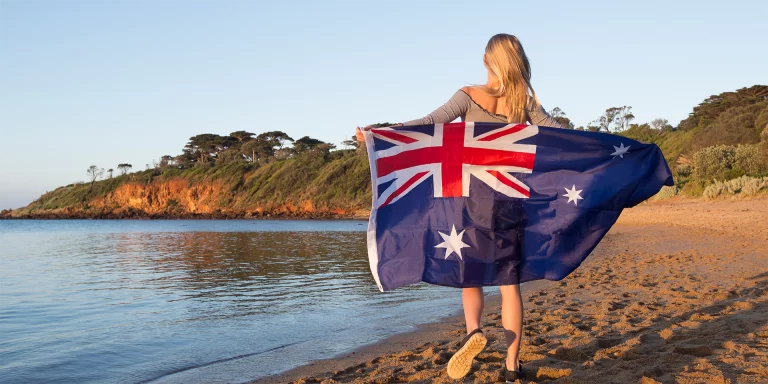BRISBANE
- BRISBANE RIVER CITY














QUOTE NOW
*Valid for payments before 31/11/2023, and contracted for a minimum of 24 weeks. Applies for courses in the morning hours.
SUMMARY
Brisbane is the third largest city in Australia and the capital of the state of Queensland. It is located on the east coast of the country, on the banks of the Brisbane River, for which it is nicknamed River City. In addition, the city is an important commercial, financial, cultural and tourist center.
Among other things, Brisbane is known for its warm, sunny climate, relaxed lifestyle and cultural diversity. The city is also a popular destination for international students, as it offers a wide range of high-quality universities, a vibrant student life and a relatively low cost of living.
If you are thinking of studying in Australia, Brisbane is an excellent choice. The city offers something for everyone, from cultural and leisure attractions to work and internship opportunities. With its warm climate, relaxed lifestyle and cultural diversity, Brisbane is the perfect place to study and live.
HERE ARE SOME OF THE FACTORS THAT MAKE BRISBANE A GREAT CITY TO STUDY IN:
- Warm and sunny climate: it has a subtropical climate that is ideal for students who want to enjoy the outdoors. The average annual temperature is 22 degrees Celsius, with hot summers and mild winters.
- Quality education: it has several prestigious universities offering a wide range of undergraduate and postgraduate programs. Queensland University, Griffith University and Queensland University of Technology are among the best universities in Australia.
- Affordable cost of living: Brisbane is more affordable than other Australian cities. This is because the city has a large student population and a competitive property market.
- Vibrant cultural life: it has a vibrant cultural life with a variety of museums, art galleries, theaters and entertainment centers. The city also hosts a number of festivals and events throughout the year.
- Easy access to nature: Brisbane is surrounded by nature, with beaches, national parks and mountains within easy reach. This makes it easy for students to escape the hustle and bustle of the city and enjoy the great outdoors.
IF YOU ARE LOOKING FOR A PLACE TO STUDY IN AUSTRALIA, BRISBANE IS A GREAT CHOICE. THE CITY OFFERS AN EXCELLENT QUALITY OF LIFE, A WARM AND SUNNY CLIMATE AND A WIDE VARIETY OF CULTURAL AND RECREATIONAL ACTIVITIES.
- PROS AND CONS
- WEATHER
- LOCATION
- WHAT TO VISIT?
- PUBLIC TRANSPORT
Pros
- Mild climate: Brisbane enjoys a subtropical climate with mild winters and warm summers, creating a pleasant environment for year-round living and study.
- Outdoor lifestyle: The city is surrounded by beautiful parks, nature reserves and nearby beaches, offering many opportunities to enjoy outdoor activities and an active lifestyle.
- Relaxed atmosphere: Although it is a growing city, Brisbane maintains a more relaxed atmosphere compared to larger cities such as Sydney or Melbourne, which may appeal to those looking for a more laid-back experience.
- Emerging job opportunities: Brisbane is experiencing economic growth and investment in a variety of industries, which is creating emerging job opportunities in sectors such as technology, renewable energy and services.
- Lower cost of living: Compared to larger cities such as Sydney or Melbourne, Brisbane offers a lower cost of living, which can be beneficial for students looking to live more economically.
CONS
- Less extensive public transport: Brisbane’s public transport system may be less extensive compared to larger cities, which may require additional planning to get around the city.
- Less cosmopolitan culture: Although Brisbane has a growing cultural diversity, its cultural and entertainment offerings may be more limited compared to larger, cosmopolitan cities such as Sydney or Melbourne.
- Hot and humid climate in summer: While many enjoy the warm weather, others may find that the heat and humidity during the summer months can be uncomfortable.
- Distance to other major cities: Brisbane is located further north and may be further away from other major cities on Australia’s east coast, which may limit some travel options and connections.
In summary, Brisbane offers a pleasant climate, a wide variety of outdoor opportunities and a relaxed atmosphere, all at a more affordable cost of living. However, the city may be limited in terms of public transport and cultural offerings compared to other larger, more cosmopolitan cities in Australia.
Brisbane's climate is characterized as subtropical, which means that it offers pleasant temperatures for much of the year.
- Summers are hot and humid, with average temperatures ranging from 21°C to 29°C (70°F to 86°F). During these months, it is common to enjoy sunny days and the occasional summer rain that cools the atmosphere.
- Winters are mild and dry, with average temperatures ranging from 10°C to 21°C, providing a pleasant climate for outdoor activities.
- Brisbane also enjoys mild springs and autumns, with temperatures ranging from 15°C to 25°C, providing pleasant weather for much of the year.
Overall, Brisbane's subtropical climate provides a comfortable and attractive environment in which to live, study and enjoy the region's many natural attractions. Although, like most Australian cities, the best time of year to visit would be during the spring (September to November) or autumn (March to May), as the weather is milder and more pleasant, and there are fewer tourists.
- Brisbane is the capital of the state of Queensland, located in northeastern Australia.
- The city is located on the banks of the Brisbane River, at the mouth of the Mary River.
- Brisbane is about 800 kilometers north of Sydney, Australia's largest city, and about 1,200 kilometers south of Cairns, the largest city in the state of Queensland.
- Brisbane is connected to other Australian cities by road, rail and air.
- Brisbane Airport is the second largest airport in Australia, after Sydney Airport.
- Brisbane is conveniently located for exploring the beautiful beaches and natural attractions of the Queensland region.
- The city is a gateway for trips to the Great Barrier Reef, the Daintree Rainforest and other stunning areas of North Queensland.
- Its location makes it an excellent base for exploring both the urban culture and natural beauty of the country.
- South Bank: is a suburb located on the south bank of the Brisbane River, a popular tourist and residential destination, and has a variety of attractions, including the Queensland Museum, the Queensland Museum of Contemporary Art, and the Queensland Performing Arts Centre.
- The Story Bridge: It is a suspension bridge that crosses the Brisbane River. It is one of the most iconic bridges in Brisbane and offers stunning views of the city.
- Queensland Art Gallery: It is an art museum that houses a collection of Australian and international art. It offers a variety of exhibitions and educational programs.
- Brisbane Powerhouse: It is an arts and cultural center that is in a former power station. It offers a variety of exhibitions, performances, and events.
- Brisbane Botanic Gardens: A botanic garden located in the city center. It has a wide variety of plants from around the world and offers a variety of activities and events.
- Mount Coot-tha: It is a mountain located on the outskirts of Brisbane. It offers impressive views of the city, and is a popular destination for hiking, cycling and picnics.
- Gold Coast: It is a coastal city located about 60 kilometers south of Brisbane. It is known for its beaches, theme parks and nightlife.
- The Daintree Rainforest: It is a tropical rainforest located in the extreme north of Queensland. It is the oldest tropical rainforest in the world and is declared a World Heritage Site by UNESCO.
- The Great Barrier Reef: It is the largest coral reef in the world. It is located off the coast of Queensland and is a popular tourist destination.
These are just a few of the many places an international student should visit in Brisbane. The city has something to offer everyone, from cultural attractions to outdoor activities.
Public transport in Brisbane is an affordable and convenient way to get around the city. Ticket prices vary depending on the service you use and the distance you travel, and can be purchased with cash or a Go Card.
The Go Card is a plastic card that can be used for travel on all Brisbane public transport services. It can be purchased at train stations, bus stations and ferries and can be topped up with cash or a credit card.
Below, you will find the most important details you should keep in mind regarding public transport in the city:
- Public transport in Brisbane is operated by TransLink.
- TransLink offers a variety of services, including buses, trains, ferries and streetcars.
- Buses are the most popular form of public transport in Brisbane.
- Trains are faster than buses but are not as widespread.
- Ferries are a good option for travel on the Brisbane River.
- Streetcars are a historic means of public transport used in the city center.






